What happens when you can't wait for perfect conditions?
“You build better solutions”
While global attention focuses on carbon accounting frameworks and net-zero pledges, some of the most practical decarbonization breakthroughs are emerging from regions where those frameworks are still developing. In Asia Pacific's fragmented landscape—where grids run on coal, water gets rationed seasonally, and environmental standards shift by province—manufacturers can’t sit around and wait for ideal conditions.
So they're innovating around constraints, and in that process, accidentally building tomorrow's sustainability playbook.
The Capital Myth
123 GWh. That’s the energy Schaeffler saved between 2020 and 2024. The number looks impressive on paper, but what's more revealing is how it was achieved.
Sustainability conversations tend to orbit around big-ticket investments and attention-grabbing infrastructure – the kind of projects that come with ribbon cuttings and press releases. But across Asia Pacific, the real decarbonization story played out in maintenance logs and equipment specs.
Facilities replaced aging compressors with fewer, more efficient ones. High-efficiency pumps went in where old ones wore out. Cold cleaning was implemented across multiple plants, from India to Korea. None of this required breakthrough technology or massive capital approvals. It just required paying attention.

The cumulative result was over 14 GWh of regional savings – a 36% overdelivery that led all other regions globally.
What changed wasn't the equipment budget. It was who started caring about energy performance. When maintenance crews, production planners, and line engineers all begin tracking energy the same way they track quality metrics, efficiency stops being a sustainability initiative and becomes operational habit.
The lesson isn't about doing more with less capital, though that helps in markets where budgets stay tight and infrastructure stays imperfect. It's that the most replicable sustainability gains often come from asking better questions about systems already in place, not waiting for perfect conditions to invest in new ones.
Waste Becomes the New KPI
50%. That's how much Schaeffler’s plants in Asia Pacific cut non-recyclable waste rates by May 2025, surpassing regional targets ahead of schedule.
Here's the thing about waste: it's brutally honest. Unlike energy efficiency or carbon calculations, which can vary depending on calculation methods or boundary definitions, there's no ambiguity with a dumpster. Either materials get reused or they don't.
This isn’t just a shift in operations, but one that reflects Schaeffler’s philosophy of engineering systems with intention and responsibility. Waste reduction has become a core strategic indicator, driving the transition to circular economy thinking. Instead of managing disposal, the focus moves to eliminating waste at source through better recycling processes and recovery measures.
When teams stop seeing discarded materials as inevitable byproducts and start viewing them as design failures, everything changes. That mental flip transforms every employee into a systems optimizer, reshaping operations for a cleaner future.[SS2]
Progress in waste reduction is only one part of the story. Once teams begin to rethink what leaves a factory floor, it’s only natural to ask what flows through it. The same engineering mindset that turns waste into opportunity is now being applied to one of the region’s most critical resources: water.
Water Wakes Everyone Up
75,000. That’s how many cubic meters of water were saved across Schaeffler’s operations in Asia Pacific between 2022 and 2024; not through moonshot technologies, but through rethinking the basics. In a region where water scarcity is fast becoming a strategic risk, conservation represents operational foresight, not just a compliance issue.
What the experience shows is this: water savings are a test of how well a system can adapt under pressure. Whether it’s reusing rejected process water or repurposing condensation for secondary use, the real shift is mindset-driven.
Across the manufacturing sector, companies that embed water resilience into everyday decisions are discovering leaner processes, smarter utilities, and teams more attuned to resource realities. In fact, manufacturing and industrial facilities participating in the national Water Efficiency Fund in Singapore have implemented over 375 water-saving projects since 2007, projected to save more than 70 million litres of water per day once fully realised. These shifts prove that sustainability gains often start with what can be measured and managed inside the plant.

Sustainability doesn’t end at the factory gate. Once internal systems become more efficient, the next frontier lies in understanding how materials, energy, and emissions move through the wider network. And that’s where the real challenge begins: across the supply chain.
The Supply Chain Reality That Most Underestimate
95%. That's the share of total carbon footprint represented by Scope 3 emissions, which is everything that happens upstream and downstream of your facility.
Here's a fundamental challenge in manufacturing sustainability: even perfect facility-level optimization can only address a fraction of your environmental impact.
In Asia Pacific, where supply chains span multiple countries with varying emissions standards and measurement capabilities, managing carbon performance becomes exponentially complex. For example, Korean manufacturers are finding that their overall carbon intensity depends as much on the efficiency of Vietnamese sub-suppliers as on their own facility investments.
The solution isn't better carbon accounting software, but supplier partnerships that align incentives around shared efficiency targets alongside traditional cost and quality metrics.
When we started requesting energy consumption data from our suppliers in 2023, the pushback was swift: too complex, too expensive, too invasive. But suppliers who engaged found something unexpected; facilities that can measure energy usage accurately tend to run more efficiently overall. Better data discipline correlates with better operational discipline.
This creates an important shift in how we think about supply chain sustainability: it's not just about compliance or risk management—it's about identifying operational excellence. Suppliers who can demonstrate resource efficiency are positioning themselves for competitive advantage in a market where sustainability performance is increasingly influencing procurement decisions.
The Asia Pacific Advantage
136%. That's how much our Asia Pacific plants over-delivered on our global energy savings targets in 2024.
Manufacturing in Asia Pacific means dealing with unstable grids, variable regulations, and climate volatility. Sounds terrible for business, right? Except these "disadvantages" are creating superior problem-solving capabilities.
Companies here have learned to make efficiency gains with off-the-shelf components and operational tweaks. They've embedded sustainability into daily routines rather than treating it as a separate initiative. In Singapore, for instance, manufacturing output per worker rose 61 percent between 2015 and 2021 even though the number of plants grew by less than 9 percent, underscoring how firms achieved productivity gains through process optimisation rather than expansion.

As carbon pricing spreads globally, water scarcity hits new regions, and supply disruptions multiply, every manufacturer will face Asia Pacific's current reality. The question isn't whether resource constraints are coming—it's whether you'll be ready when perfect conditions become ancient history.
What This Means for Global Manufacturing
Three principles are emerging from Asia Pacific's sustainability innovations:
Start local, think later. While others wait for global frameworks, manufacturers here stack marginal gains. The cumulative impact often exceeds planned efficiency programs.
Make it everyone's job. Energy optimization works best as a cross-functional skill, not a specialist's domain. When line operators care about energy costs, magic happens.
Optimize humans, not just systems. Smart factories succeed when people can interpret and act on data, not when algorithms make decisions for them.
The manufacturers emerging as leaders aren't the ones with the biggest budgets or fanciest technology. They're the ones who've learned that constraints breed creativity, and creativity scales.
